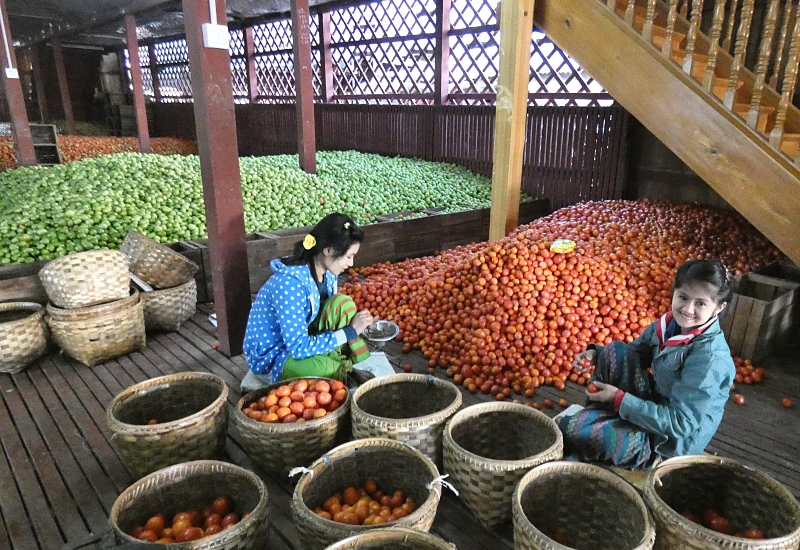|
|
Last update: 18 Apr 2024 Inle Lake off the beaten track
IntroductionInle Lake is a mountain lake located in the famous Shan highlands or Shan Hills. The lake lies in the middle of the wide Balu Valley at about 900 meters above sea level; and just north of the lake is the village of Nyaung Shwe, the trade hub and focal point of Inle. On the lake there are about twenty villages of the Intha tribe who live on the water in stilt houses and along the lake shore. The villagers practice aquaculture in a way that is unique; they grow mostly tomatoes but also other vegetables on floating plant beds made from Elephant grass. Apart from the boat trip the best activity around Inle may well be a long bicycle tour around the lake shore, passing through the villages that dot the countryside between the parallel mountain ranges. After you have done the boat tour why not take a trip off the beaten path? All you need is a bicycle, a sun hat, some water and to be reasonably fit. You can just bike through Nyaung Shwe or go to the Red Mountain Vineyard. A quick trip up north to the Shwe Yan Pyay monastery is also fun and takes only 15 minutes. Where to stay in Inle?One can stay in a resort on Inle lake or in a hotel or guesthouse in Nyaung Shwe; the hub of Inle. The resorts on the lake are quite expensive; a guesthouse or hotel in Nyaung Shwe is a lot cheaper, and there are many new modern hotels in town. There are no guesthouses in any of the small villages around Inle Lake; only resorts on the lakeside, or even in the lake. Nyaung Shwe is the lively central town with daily markets and lots of restaurants; the resorts have peace and quiet and nice sunsets. The resorts on the lake are not always quiet though; because there can be noisy boats on the lake in the daytime. For that reason, many lake resorts are set back, located a bit to the side of the lake on a private pond or lake area. Also, if you stay on the lake you can have some mosquitos after sunset; in winter season there are only very few mosquitos in Nyaung Shwe town. Some of the resorts which are located on the banks of Inle lake can reached by taxi; but most travel around the lake is done by longboat. However, you may feel a bit stuck in a lake resort because there are no boats at night, so a dinner in Nyaung Shwe is a bit complicated. When choosing a resort, it is smart to look very carefully at its restaurant review ... in most lake resorts you are a "captive guest". In my opinion a lake resort or a posh fenced hotel can isolate you from the charming local village life. If you want to get a feel for a small Shan town then by all means stay in Nyaung Shwe. The locals in Nyaung Shwe also speak some English, which is convenient.
Inle Lake bicycle map.
It is best to start biking in the morning and take some water along, the cool morning will last until noon. In the hot afternoon the big smiles on most bikers' faces will change to more determined looks. Later, after 3 PM things cool down pretty fast to pleasant temperatures. The nights in Inle are quite cold in winter.
Red bicycle route: From Nyaung Shwe 11 km to Maing Thauk - about 1 hour, one way.
Blue bicycle route: From Nyaung Shwe 12 km to Khaung Daing - about 1 hour, one way.
Inle Lake Loop - First cycle to Maing Thauk and have a lunch in one of the many eateries near the walking bridge. From there take a longboat to Khaung Daing. The ferry trip takes half an hour and it is always easy to find a boatman. Nowadays there is a tout (fixer) on the walking jetty that arranges a boat for you for 10.000 kyat. From Khaung Daing just go up North, past the hot springs, and back to Nyaung Shwe. This trip takes a minimum of 3 hours; unless you are a trained bicyclist it is better to plan on four hours and have a break or lunch somewhere during the hottest part of the day. As a side note: The bicycle route between the lake and mountainside has surprisingly few views of the lake. Even though there is a nice view from the steep hill of the Red Mountain vineyard, the lake is quite far away in the distance. To see the lake, you could visit some of the hill-side monasteries; though some are quite a climb, and you will burn many calories in doing so. Or you could take it easy and go to the long walking bridge at Maing Thauk, and perhaps take a boat to the other side. Which bike and route to choose?The roads are mostly on level terrain so some people take a simple bike from their hotel. I usually rent a mountain bike because it is faster and you can explore some of the smaller dirt roads towards the lake or to the mountainside. A simple bicycle with three gears is about 3000 kyat per day, renting a good mountain bike can cost from 5 to 10 dollars. Five Star rental, opposite the large Royal Nyaung Shwe Hotel, has mountain bikes with 7 gears for 4000 kyat. Doing the full loop will take 3 hours on a mountain bicycle; on a simple bicycle it might take much longer. If you get a flat tire there is usually someone not too far away that can fix it for you. Mountain bikes usually have sturdier tires. The Blue bicycle route is a small one-lane road with more traffic than the red route - sometimes large trucks and busses. The road to Maing Thauk on the Red bicycle route is wider and better; and Maing Thauk with its long jetty and many eateries is more charming than Khaung Daing. Can everyone do it? The full Inle lake loop is an intermediate bike ride with mostly flat roads. If you ride a bicycle regularly and are in good shape it should be no problem but it is no walk in the park! It is not easy for everyone, a two-hour bike ride will be quite tiring in the tropical sunshine. It is also not for young children. If you think a one-hour ride in your home country is difficult then I would not recommend trying it here - start with doing some biking around town and see how that goes. So, I would advise going to Maing Thauk first, have a lunch there, and if you are up for it cross by boat to Khaung Daing. I have done many one-way trips; when I got tired, I used to hitch a boat ride back to Nyaung Shwe (10000 kyat). Or you can just return the same way and visit the winery on the way back. Do have a quick look at the market of Maing Thauk just south of the long jetty; and the new large resorts just beyond it - it is an amazing contrast to the simple village houses with bamboo walls and tin roofs.
Khaung Daing hot springsThe hot springs in Khaung Daing are a bit disappointing because there are no springs as such visible, but the open-air public bath is simple but relaxing. Unfortunately, there is no view of Inle Lake. The open-air spa used to have a 3 dollars entry fee, but it with the start of the tourism boom in 2011 they created a new private "foreigners" spa (3 small ponds) and charge 10 dollars per person! The posh new spa is mixed (men and women together). You can still choose the large original spa for 5 dollars and sit in the same water, men and women have a separate pool here. The locals pay 1000 kyat. About 15 minutes biking beyond the hot springs is the village of Khaung Daing; there is not much to see except perhaps the famous "Shan tofu" made from split yellow peas.
Eateries in Maing Thauk village.The first famous place on the way to Maing Thauk is the Red Winery; situated on a steep hill on the east side of the lake. It offers wine tasting for 5000 kyat until 6pm. There is also a restaurant here with a view of the lake in the distance, and a good sunset view. A bit further down is Inle Heart View eatery.
Maing Thauk (Mine Thouk) is actually not one but two villages connected by a 600 meter long walking bridge: Maing Thauk village on the shore, and Maing Thauk Inn on the lake. The walking bridge is shorter than the famous U-Bein bridge in Mandalay but it is a great place to hang out, admire the view or have a tea or lunch. Usually there are many locals here as well, and many boats coming and going. One can walk up to the Forest monastery to explore, but the view from there may not be worth the long uphill walk. There is a large orphanage halfway up the hill, which is worth a visit. The first large house is a girl's orphanage; the boys orphanage is a bit further.
Maing Thauk has a few small restaurants (a better fitting name is eateries) which are quite popular with people who want something a wee bit different from their lake resort's menu.
The restaurants mentioned above are really just eateries; however, some simple eateries around Inle score better than the restaurants in Nyaung Shwe. It's quite ironic that many people rate a cheap meal in a local place higher than a posh dinner in an upmarket resort. Why do the simple eateries in Nyaung Shwe score so high? Perhaps for restaurants price is not always a reflection of quality, and some of the restaurants in Myanmar serve good food but charge a rather high price for foreigners. The food in resorts is often priced in dollars but in restaurants and eateries it is priced in kyats. Just keep in mind that the service of these eateries can be much slower than that of "proper" restaurants.
Pubs, Curries and Cocktails.I am not a great fan of the oily "Burmese curry" or "Indian curry" served by Burmese restaurants; but I can recommend the Innlay Hut Indian Food house in Nyaung Shwe for original Indian curries - yes, it is just a simple eatery but they make great curries. Some of the reviews are stellar, but keep in mind this is just a small eatery: "Can you imagine kind of unique place where unbelievable positive vibes meet unbelievable delicious kitchen?! Yeah, so this it ... Innlay Hut Indian Food House." The owner Stan is from Nepal; "Stan the man" will keep you entertained while his mother cooks dinner. As you may have guessed, Stan is a fan of a certain American rapper. He also likes Dutch "Stroopwafels", so when you arrive a bit late and do not have a reservation, you could try giving Stan some Stroopwafels to buy your way in (I'm not sure if this will work). The Innlay Hut Indian Food house is a bit off the Yone Gyi main road, in the southern part of town just past the night bazaar field. Yone Gyi street is the main east-west road where many restaurants are located. Also highly recommended as a good cocktail place and western-style restaurant is the Pub Asiatico on Museum road. Nyaung Shwe is just a tribal mountain village in the Shan Hills, but Pub Asiatico is a surprisingly large upmarket place that one would expect in the old capital city of Yangon. Why the three owners built such a huge restaurant in Nyaung Shwe is an open question. It is not very pub-like (perhaps it should be called Club Asiatico?) but a modern restaurant/bar with two floors and a great roof top terrace. It is certainly not an authentic Burmese restaurant; they serve pizza, burgers and fish & chips, and make plenty of cocktails. Who said there is no nightlife in Myanmar's towns? If you are in Nyaung Shwe around new year then this is the place to be. On the other hand, there is no authentic Burmese food here, and outside of the high season it can be a bit quiet. It all depends on what you crave, after all, sometimes a pizza is a nice change of the regular menu. And speaking of cocktails, Thousand Island Hotel next to the canal has happy hour during sunset on their roof terrace; there are fabulous views of the canal and boats, and it is where the photo below was made.
The Yawnghwe Haw in Nyaung Shwe.The old Shan name for "Nyaung Shwe" is Yawnghwe. The "Yawnghwe Haw" (Yawnghwe palace) is an interesting historic Shan palace in Nyaung Shwe, displaying a large number of Buddha statues. It used to be called "Museum of Shan Chiefs", after that its name was "Buddha museum"; but in 2012 it has been renamed to the "Shan Cultural museum". The museum is run by the government, however the entry is only 2 dollars so most of the fee must be going to salaries and maintenance. And if the museum does not earn its keep it might be a reason to destroy the authentic palace and put a tourist resort in its place. There is also a small Shan State Cultural Museum in Taunggyi, a small mountain town even higher and cooler than Nyaung Shwe.
Yawnghwe used to be ruled by Saopas or Sawbwas, the Lords or kings of the small feudal kingdoms of the Shan State. The "Yawnghwe Haw" was the palace of the Saopa of Yawnghwe. In 1908 a fire destroyed the original haw, located in the western quarter of the town. The ground of the old haw is now a public open space with an independence monument called Old Haw field or Independence Monument field. A new haw was constructed at the north-western corner of the town in 1913. Under the reign of Sao Shwe Thaike, the haw was inaugurated, and it became the administrative center of the town. Sao Shwe Thaike became an influential figure in Burma's history as he became the first President of the Union of Burma in 1948.
The exhibition inside the "Shan Cultural museum" gives very few clues about the history of the Haw so you will have to read up on that for yourself. The book The Moon Princess - Memories of the Shan States, by Sao Sanda is a very good read. She grew up in the Yawnghwe palace, and her father became first President of the Union of Burma. Most of the "Haws" or palaces in the Shan State have disappeared; destroyed during the war or demolished by the government of Burma which has always been in conflict with the Shan state. For example, the grand Haw in Kengtung was demolished in 1991 by the government and a modern hotel now stands in its place. The Hsipaw Haw is still being used as a private residence. Hsipaw's East Haw is well known due to Sao Kya Seng's tragic story told by his Mahadevi Inge Sargent in her book "Twilight over Burma: My life as a Shan princess." The few Haws in the Shan state that survive are:
The Kyaung or Monastery."Kyaung" is Burmese for monastery, and they are the most interesting spiritual buildings after the temples and pagoda's all over Burma. The Kyaungs in Bagan and Mandalay are often stone buildings, but the typical monasteries around Inle are mostly teak or hardwood buildings, sometimes surprisingly large. There are many, many Kyaungs around Inle lake, but only a few are on the lake itself, for example the Jumping Cat Monastery or Nga Phe Kyaung. If you want to make amazing photos of novice monks in monasteries then Inle is the place; besides Mandalay obviously. In Mandalay the Shwenandaw Kyaung is one of the last teakwood historic monasteries. Shwe In Bin Kyaung is an active teakwood monastery in another part of Mandalay. In Bagan they are difficult to find because there are fewer active monasteries and they are located away from the major temples. Inle lake has a few fascinating Kyaungs if you get on a bicycle and take the effort of a short bike ride. The most popular one - and a bit touristy - is located on the main access road down to Nyaung Shwe, the small and very old Shwe Yaunghwe Kyaung monastery which is next to the Shwe Yan Pyay pagoda. And yes, Pyay means pagoda, not monastery. On the road to Kaung Daing there are about six or seven monasteries, though you may not notice some of the ones that are hidden behind houses or on hilltops.
Another very nice monastery to visit, is Ywa Thit monastery, the first one you will see between the rice fields, as you cycle down the wobbly road westward. Here lives a very friendly monk, who is always happy to have a chat about life in general or European football in particular, and he speaks very good English. Most Buddhist monks do not speak much English, but you are always very welcome to visit one of the monasteries. And sometimes meeting the monks in a monastery can be an enlightening experience, even if you have to communicate without words. A possibility of a meeting with a spiritual guide for the local people.
Fort Stedman and Sir George Scott.Also shown on the map is the site of the British Fort Stedman in Maing Thauk village; which was the chief city for the administration of the Southern Shan states. Fort Stedman used to be situated somewhat up the hill at Maing Thauk village. If one looks towards the mountain at Maing Thauk, one sees a flat area with three large white stupas. The flat area is presumably where the barracks of Fort Stedman stood. Now there is nothing left of fort Stedman and only the three stupas mark the place (20░ 34' 55"N, 96░ 57' 10"E). In 1894 the famous Deputy Commissioner Sir George Scott (George_Scott) moved the administrative offices from Fort Stedman to the higher elevation of Taunggyi - and thus the hill town of Taunggyi was created. Sir George Scott was also the first to introduce soccer to the Burmese, with great success. For more background read the fascinating book: The trouser people, by Andrew Marshall. Or you might read "The Burman: His Life and Notions" by Shway Yoe, which was a pseudonym of George Scott. This was published in 1882, and is obviously rather dated, but a useful reference book. Just below the Fort Stedman site is an old British cemetery with a few gravestones (and some missing) which is extremely difficult to find, the people in the local Maing Thauk orphanage can show you exactly where it is. Here are the graves of Major Edward Baynes Nixon, Commandant of the 3rd Burma Regiment and of Lieutenant Edmund Walter Jamieson, the Adjutant of the same regiment who were murdered in 1891 by a Pathan sepoy. The full dramatic story is here: www.victorianweb.org/history
Which boat tour?The boat tour is the most popular activity on Inle lake. It is usually easy to get 4 or 5 people together and negotiate on the canal side with the boat driver or with the English-speaking woman who arranges the trips. If you do not have the time to get a few people together, then you can also book a shared boat trip, where an agency arranges a shared boat for you. This is cheaper than going with just one or two passengers, and maybe more fun. You can create your own boat trip: you pay, so you decide. Plan a route ahead of time and tell the driver what you want before you leave. For example, you might want to avoid the posing fishermen (who expect a tip) at the lake entrance. There are plenty of real Intha fishermen on the lake but real fishermen usually do not pose for tourists, they do not wear clean white shirts, and they do not catch fish by standing on one leg. The real fishermen catch fish, the fake ones catch the tourist dollars. The cost of the boat tour starts at fifteen dollars for a complete boat (4/5 people). Some hotels may overcharge you for the trip, at the canal side it can be less, if you negotiate. Usually a deal is a straightforward deal here, but be clear about what you want before you get into the boat. Note that the boat drivers hardly speak any English, and the engines are quite noisy.
Boat tour itineraries.The Inle Lake boat tour is a must-do when visiting Inle. Being on the lake, the Intha fishermen, the floating villages and the aquaculture is most of the fun - but there are also a few sites to visit, the best being the Phaung-Daw-U pagoda and the Lotus weaving factory. Shwe Indein hill and temple, which is a bit off the lake, is optional but certainly worth it. And some of the many other sights are a silver smith, cheroot (cigar) making, the Paper umbrella factory, lunch at a lake restaurant, the Lotus weaving factory, the Floating garden agriculture, a few of the floating villages, and the No Longer Jumping Cat Monastery Nowadays there are about ten silversmith shops around the lake which are probably not all authentic. But, you can customize your boat ride, and perhaps tell your driver not to go to silver shops. There are a few itinerary variations; for example, one can do the usual boat tour of Inle lake; or go for an extended boat tour, which goes around Inle lake, but also up the canals to Indein village. Or there is the "Sankar Lake" option; which is for the adventurous tourists. Let's have a look at these three choices.
| ||||
And a last highlight: The Five-Day markets.When you arrive at Inle lake you probably will not realize that Inle is in the middle of a tribal area, so if you are interested in hill-tribes, you could ask for the date of the five-day market. That is when many tribal people come down to the Nyaung Shwe market to sell their produce and vegetables. The Pa-O tribal women are the easiest to recognize, as they all wear a large head-scarf. These big scarfs, in many colors, look very much like towels - and perhaps they are. In northern Thailand many tourists go in search of these tribal hill people, not realizing that their way of life has mostly disappeared there, so they often end up in tourist villages. These tourist markets and villages in Thailand make money by selling souvenirs and charging entry fees. Markets in Myanmar are different; for example, the Nyaung Shwe market, has many, many tribal people who are not bothered by the one or two foreigners that may or may not point a camera at them. The ratio of foreign visitors to local people is still very low, and that creates an opportunity for authentic photography. Looking for tribal people in Burma can be a bit more difficult than in Thailand though. In Thailand's tourist villages, the Akha, Hmong and Lahu are usually in their tribal attire. If you are having a nice tea on the side of Yone Gyi street, the main road in Nyaung Shwe, you will probably recognize the Pa-O tribe, but not the many other tribes, because they do not wear a tribal costume. The tribal people here do not speak much English, so you might be tempted to talk in Burmese to them, but, they probably speak the Shan language, or more likely a tribal language. Believe it or not, the majority of people walking past you are members of a tribe. You just will not know which tribe. The Five-Day market is held daily but the location rotates through 5 different sites around the lake area, including Nyaung Shwe, Heho, Taunggyi, Maing Thauk and Khaung Daing. These markets are not only visited by the Intha, but also Taungyo, Pa-O, Danu and Danaw tribal people. The Intha tribe lives on and around Inle lake itself; but many of the market sellers are Pa-O tribal people, who live in villages in the eastern mountain range and on the south side of the lake. More info on the Five-day market in 2021: travel-myanmar.net.
A Hard Sell on Inle lake?Inle lake has become quite touristy in the last 10 years, so is it a tourist trap or not? That is a valid question and worth asking. Yes, Inle has become quite popular, and for example Indein village can be a bit busy with other boats. And what about the commission your boat driver might get during the stops at some of the shops? A tourist trap is an experience, site or shop that has been created with the aim of attracting tourists and their money; a good example is the night market in Nyaung Shwe, set up a few years ago for tourists. The "shops" on Inle lake however, are real workshops or businesses, that make real products. The lotus weaving shops makes famous textiles (and there has been silk weaving for more than 100 years on the lake), the boat building factory makes teak boats, and there are paper making shops that make paper from tree-bark. All these traditional Shan craftsmanship factories are original, except some of the silversmith shops - there are just a few too many of them around. The people around Inle lake make a living that, for the most part, does not depend on tourism. The lake is used for aquaculture, and the tomatoes and other vegetables that are grown on the lake are distributed all over Myanmar.
Inle Lake is Myanmar's largest tomato growing centre, and in harvest season the tomato farmers can produce up to 90.000 kilos of hydroponic tomatoes a day. The floating-island aquaculture system on Inlay Lake is the largest hydroponics farming zone in the world. The tomato is used in many Myanmar dishes, such as chicken, pork and vegetable curries, as well as tomato salad. Thus, there is no need to worry about Inle being a tourist trap. The boat tours are cheap, you pay about fifteen dollars for an all-day boat tour. That is a fair price, and very cheap compared to boat tours in other countries, for example at Tonle Sap lake near Angkor Wat. That boat tour in Tonle Sap lake will cost you 30 dollars for just one or two hours, and includes a hard sell of "rice for the orphanage" if you are gullible. You can easily avoid the touristy things around Inle lake. For example, you might want to avoid the posing fishermen (who expect a tip) at the lake entrance. There are plenty of real Intha fishermen on the lake but they normally do not pose for tourists. If you tell them, the boat drivers will skip the shops and touristy sights. But really, I have done many, many boat tours, and I am sure that if there is a commission involved somewhere, it is a very small sum. The boat drivers might get a simple rice meal while you have lunch, but so what? These guys make very little money, likely less than 10 dollars a day. The fifteen dollars for an all-day boat tour is dirt cheap, so what if there is a quick free meal for the driver. Don't worry about it. There is no "Hard sell" in Inle. The shopkeepers are very nice, they may offer you some tea but there is never any sales pressure. Myanmar is very different from India or Cambodia, where scams are quite common. Burmese people are poor, but scrupulously honest. They are not after your money. Yes, a bit of a haggle is OK, but always in good humor and with mutual respect. Relax, and enjoy the boat trip, it is the best one in the world.
Wiki and Wikitravel links.
The Inle Heritage Foundation at Innpawkhon village is a non-profit organization which focuses on cultural and environmental sustainability. It is a hospitality training center which runs a small resort of stilt houses, the Inle Heritage Hospitality Vocational Training School and a restaurant. www.tripadvisor.com scribd.com/Michalon - A thesis on tourism, aquaculture, pesticides, fishery, deforestation, environmental issues by Martin Michalon. And information on the history of hotels and resorts on the lake. teacircleoxford.com - Martin Michalon explains the effects of tourism on the Inlay Lake Region.
Coordinates of Nyaung Shwe and Sankar.
| Bicycling around Inle lake has become really popular; and people from many countries have done it and blogged about it. My bicycle map has been copied many times and, though I am not very happy about that, I take it as a compliment. I do update the Inle Lake map regularly; and that is why I would prefer it if you place only a LINK to my map on your website.
|
|
"Much have I travelled in the land of gold,
|


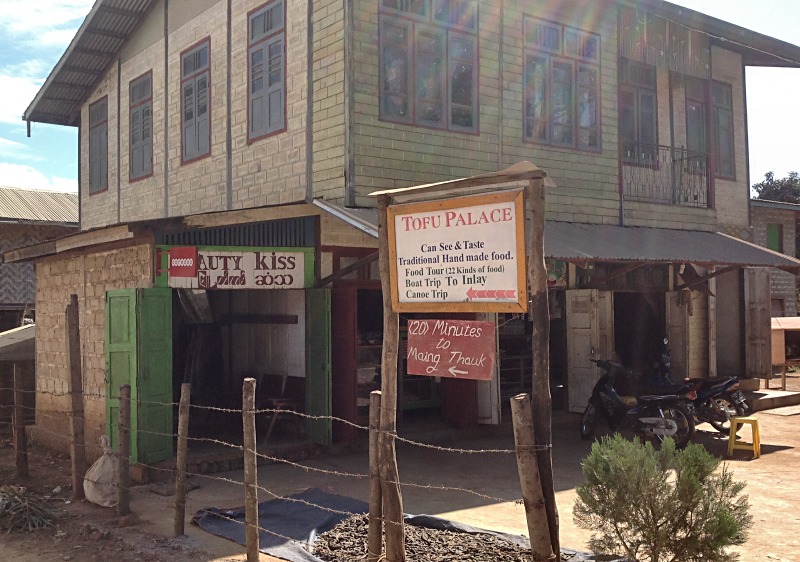
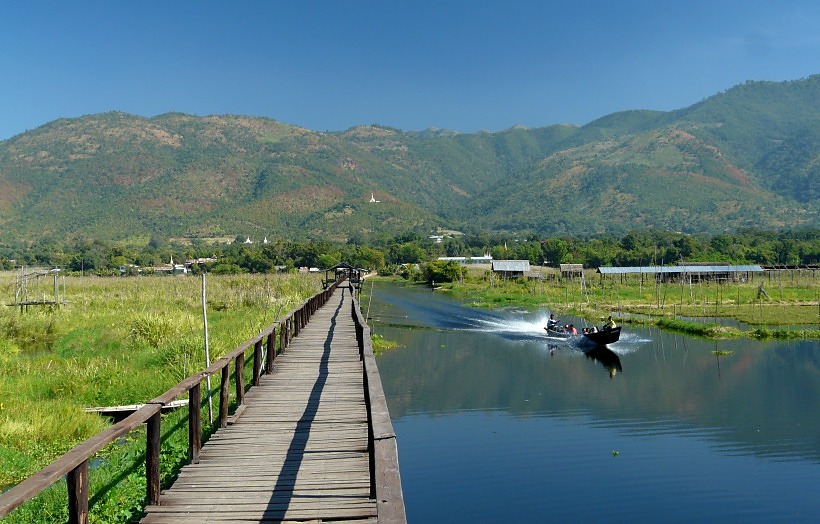
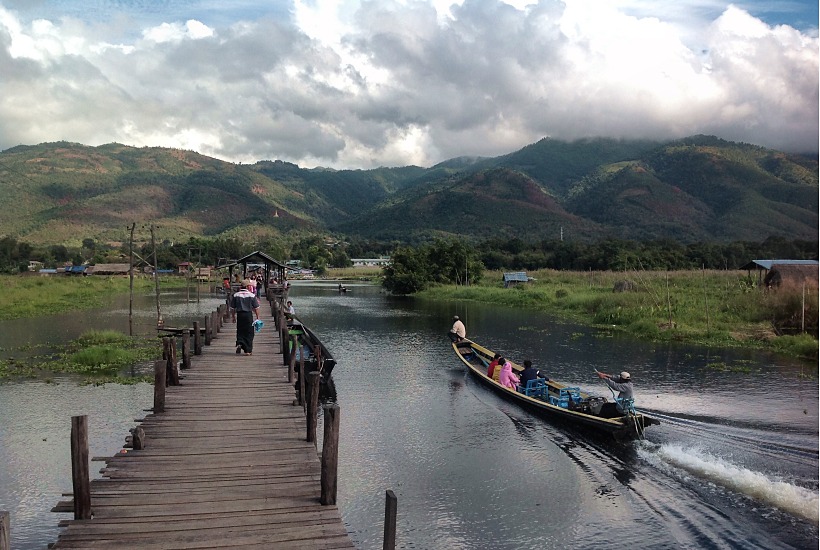
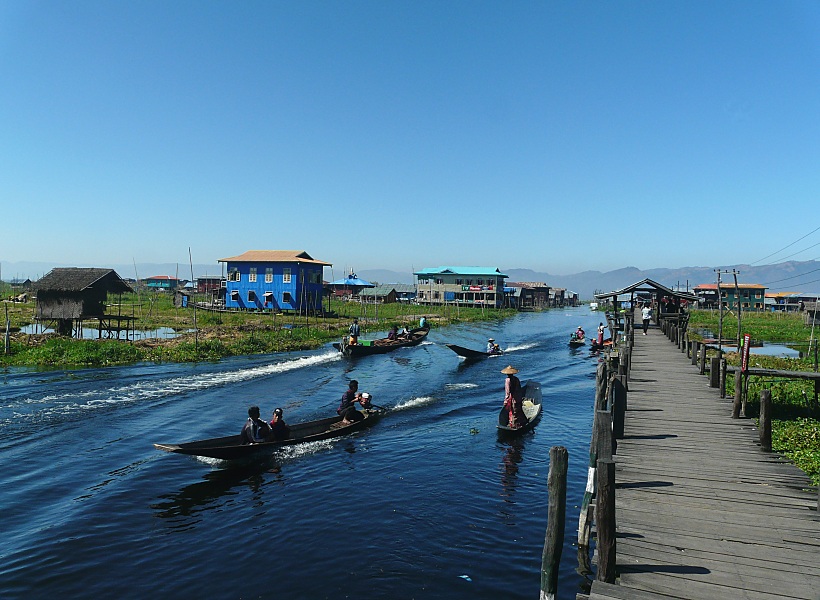
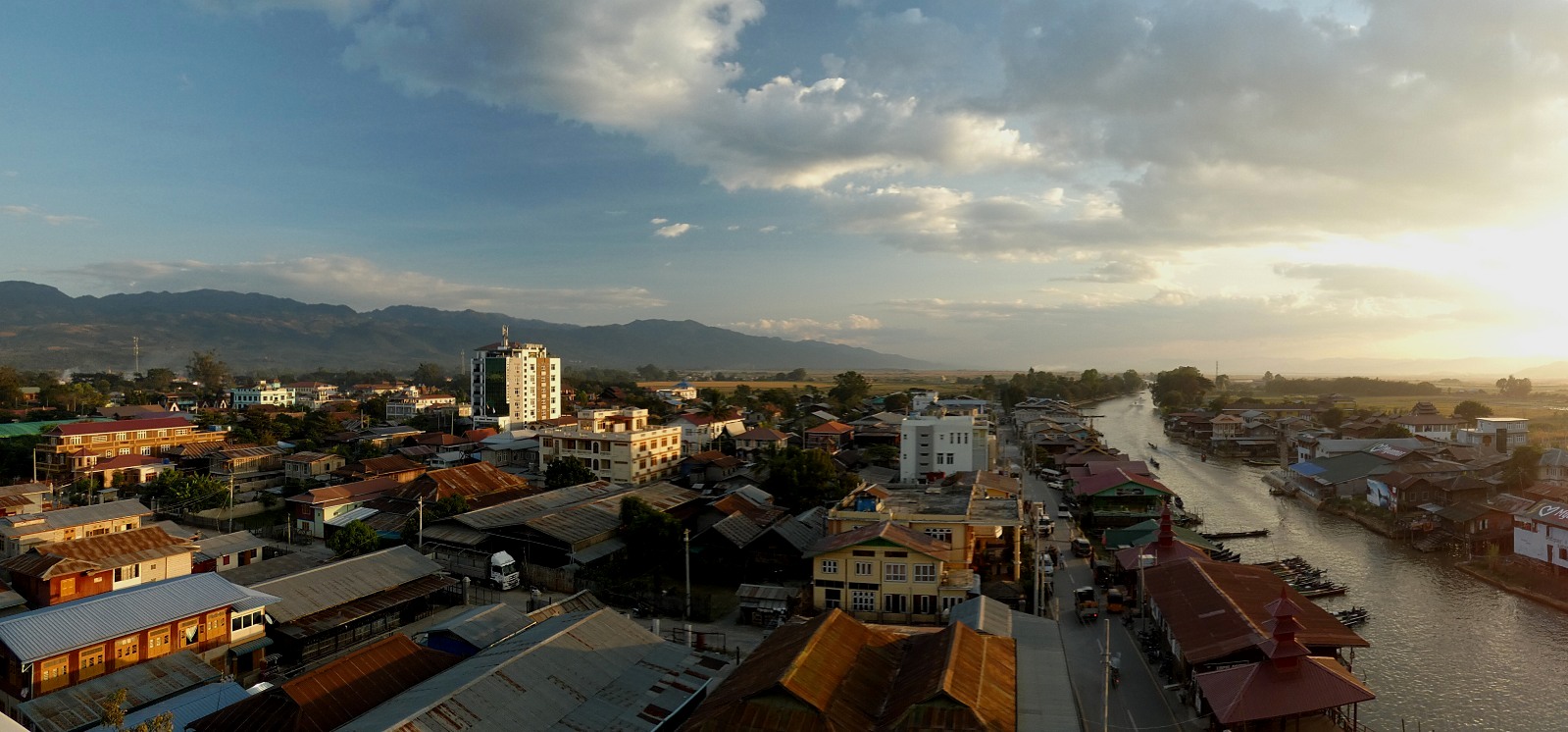

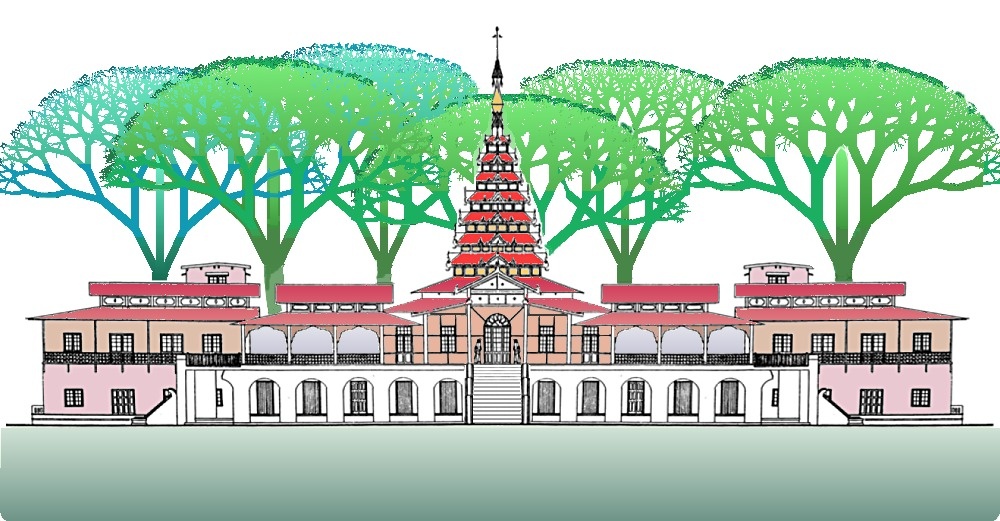
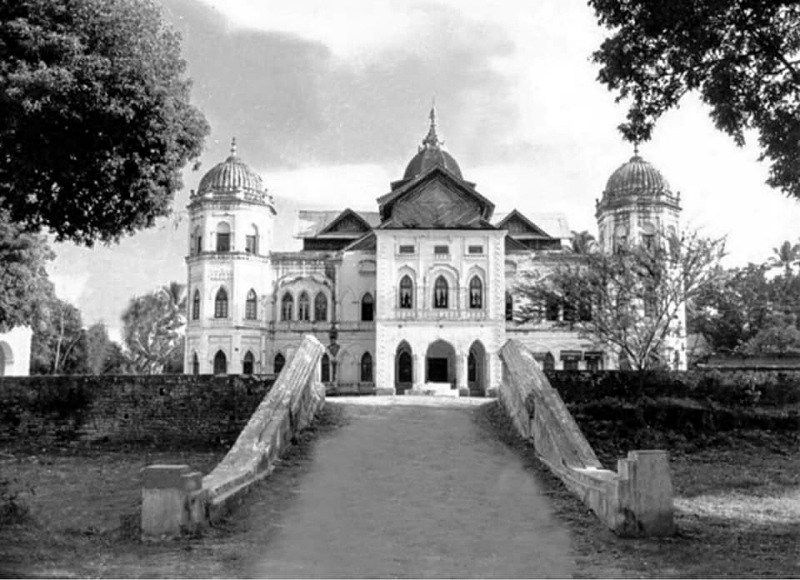
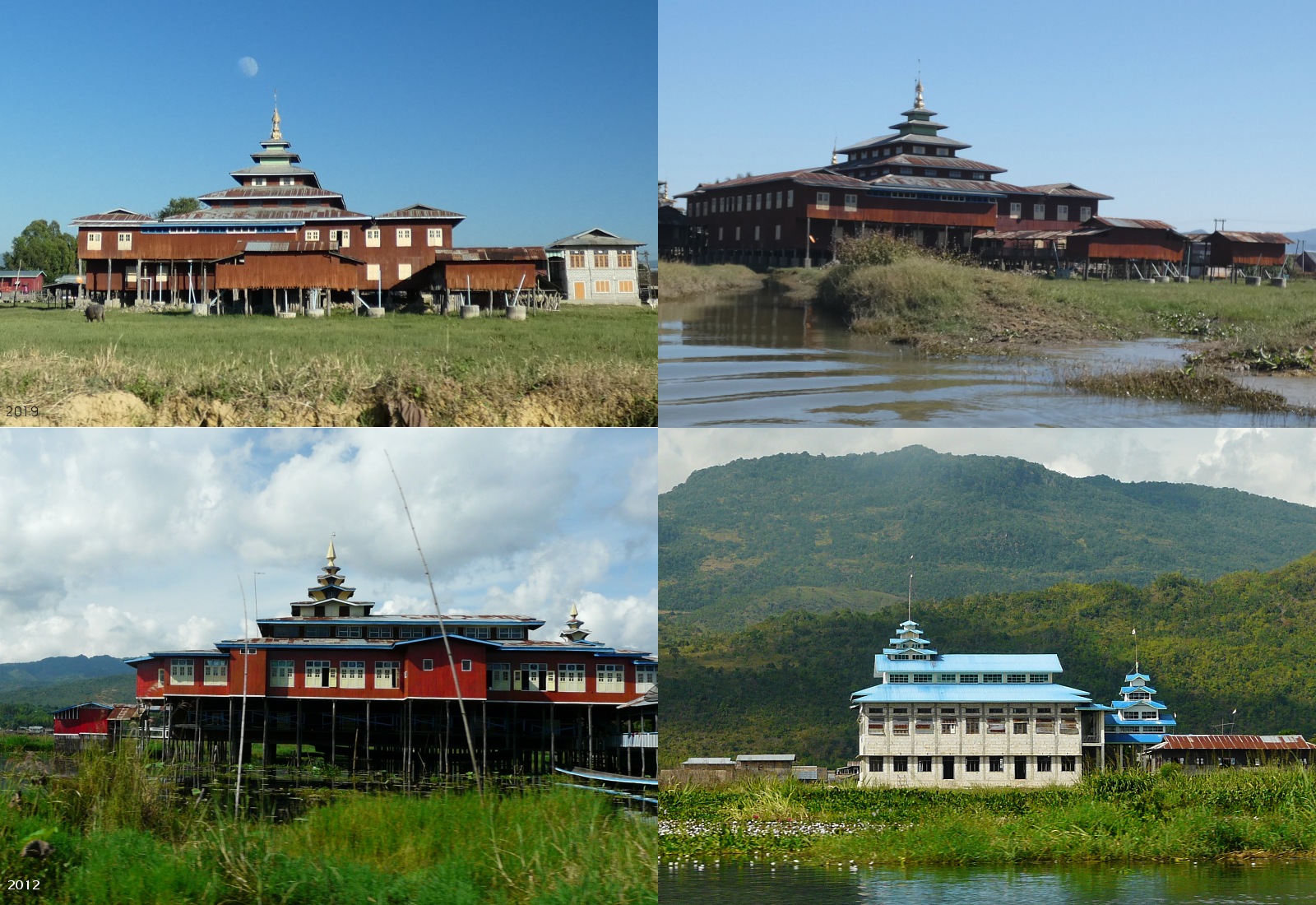
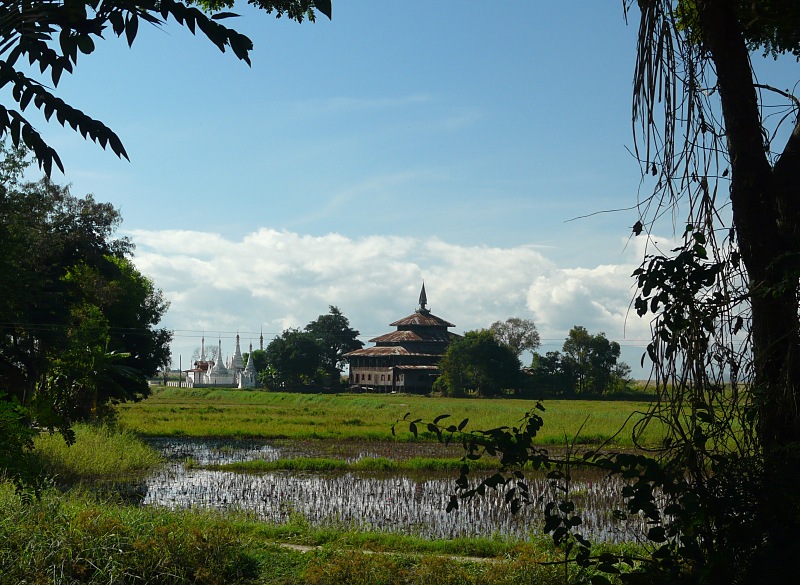
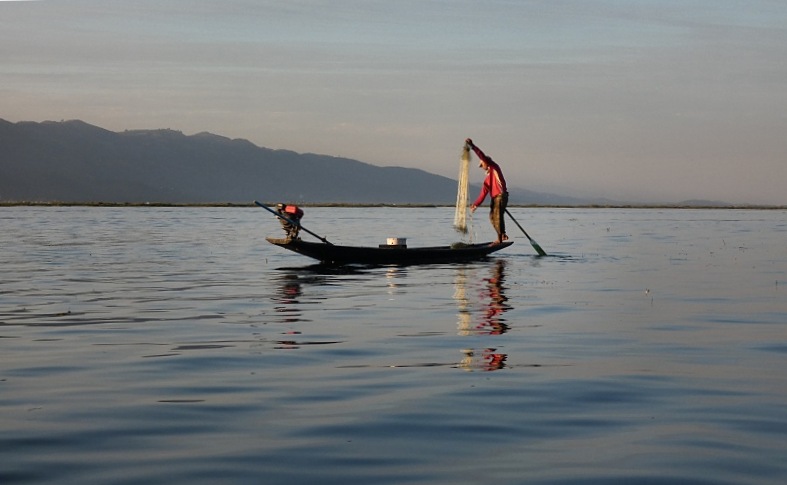
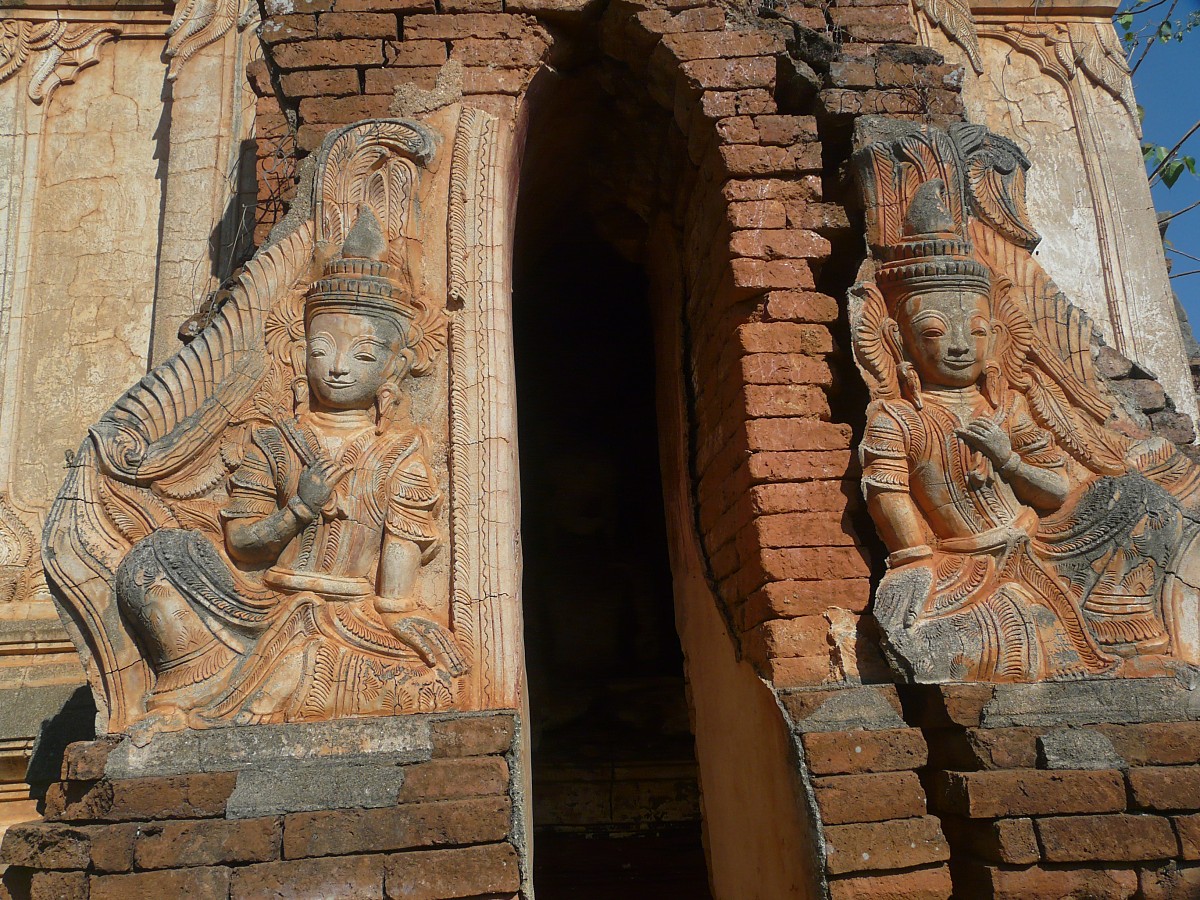
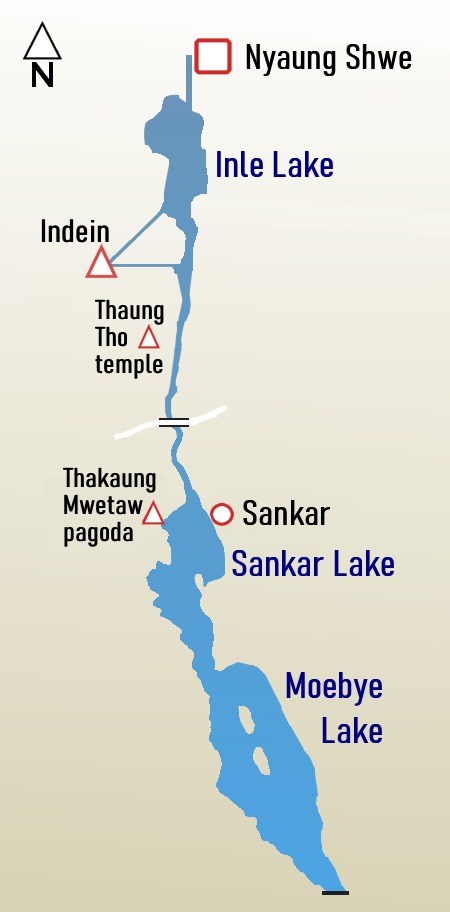 3] The Sankar Lake full-day boat tour goes to Sankar village, which is not on Inle lake but another lake down south, reachable by a three-hour boat trip through a long winding creek.
3] The Sankar Lake full-day boat tour goes to Sankar village, which is not on Inle lake but another lake down south, reachable by a three-hour boat trip through a long winding creek.



